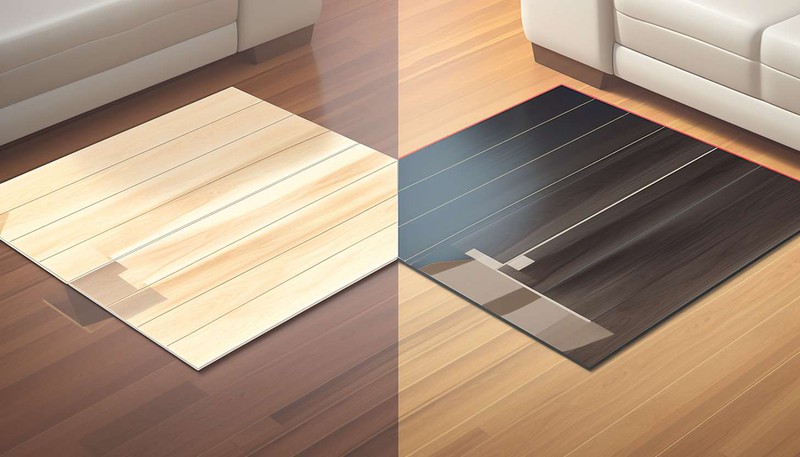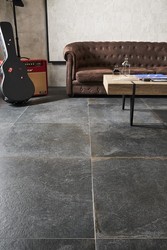Differences between laminate flooring and vinyl flooring: What is the best option for your home?
These two ideas are a brief summary of the differences between laminate flooring and vinyl flooring
- Laminate flooring is often cheaper in terms of initial price.
- Vinyl floors offer greater durability and resistance to stains, justifying their price.
Laminate floors and vinyl floors have some differences and similarities in terms of resistance, ease of cleaning, installation and design. Laminate floorsare easy to clean but more susceptible to scratches, while vinyl floors are more resistant to stains and wear. Both types of floors are easy to install, but laminates are faster due to their click system. Regarding design, laminates offer greater variety, while vinyl imitates different materials with great realism. Price can also be a factor to consider.
Differences in strength and durability
One of the main differences between laminate flooring and vinyl flooring is their strength and durability. Laminate floors are made up of several layers, with the top layer being the one that provides resistance to scratches and wear.
While generally durable, laminate floors are more susceptible to scratches and scuff marks compared to vinyl floors. This is due to the fact that the top layer of laminate floors has a composition of melamine and resins, which can be easily scratched if subjected to sharp or abrasive objects.
In contrast, vinyl floors are known for their high resistance to wear and scratches. They are designed to withstand heavy traffic and the most challenging conditions. The top layer of vinyl flooring is durable and strong, making it ideal for high-traffic areas like kitchens and bathrooms.
In addition, vinyl floors are also more resistant to staining and fading caused by prolonged exposure to sunlight. This makes them a popular choice for spaces that are exposed to direct sunlight for long periods of time.
Ease of cleaning and maintenance of vinyl and laminate floors
Ease of cleaning and maintenance is an important factor to consider when choosing between laminate and vinyl floors. Both types of floors offer advantages in this regard.
Laminate flooring
Laminate floors are easy to clean thanks to their non-porous surface, which prevents the absorption of liquids and stains. For its daily cleaning, it is enough to sweep or vacuum the floor to remove dirt and dust. In addition, it is recommended to use a slightly moistened mop with specific cleaning products for laminate floors.
It is important to avoid the use of abrasive products or aggressive chemicals, as they can damage the surface layer of the laminate flooring. Similarly, cleaning tools with hard bristles that can cause scratches on the surface should be avoided. In the event of spills, they must be cleaned up immediately to prevent liquid from entering the joints and causing damage to the underlying layers.
Regarding maintenance, it is advisable to use furniture protectors or felt feet under the furniture to avoid marks or scratches on the floor. In addition, it is important to avoid dragging heavy objects that could damage the surface of the laminate.
Vinyl flooring
Vinyl floors also stand out for their ease of cleaning. Being waterproof and resistant to stains, cleaning can be done simply with a damp cloth and non-abrasive cleaning products. In this way, any dirt or stain can be effectively removed without damaging the surface.
Like laminate floors, it is important to avoid the use of aggressive chemicals or abrasive products that can deteriorate the floor's protective layer.
In terms of maintenance, vinyl floors They are durable and require little care. However, it is recommended to avoid dragging heavy furniture and place furniture protectors to prevent marks or scratches on the surface. It is also suggested to avoid exposing vinyl flooring to high temperatures or direct sunlight, as this can affect its appearance and long-term durability.
Installation process for each type of floor
Next, we will see in detail how the installation of laminate floors and vinyl floors is carried out. If you are considering renovating your floors, this information will be very useful to decide which is the most suitable option for you.
Laminate flooring installation
The installation process for laminate flooring is relatively simple and can be done by a do-it-yourselfer. Next, we explain the steps to follow:
Preparation: Before you begin, make sure the floor where the laminate will be installed is clean, level, and dry. Remove any type of previous coating and make sure there are no irregularities in the surface.
Underlayment: The first step is to lay a foam or polyethylene underlayment over the floor to provide greater sound absorption and to even out small imperfections. Be sure to cover the entire surface with the base coat.
Laminate installation: Next, start installing the laminate around one corner of the room. Use the tongues and grooves on the boards to fit them together. As you go, be sure to leave a small expansion gap at the joints and use shims to hold them in place as you continue with the installation.
Finishing: Once you have installed all the boards, cut off any pieces that are left in the corners or around fixed objects. Then, install skirting boards to hide the edges of the laminate and give the room an aesthetic finish.
Vinyl flooring installation
Installing vinyl flooring is also a relatively simple process and can be done by anyone with basic DIY skills. Here are the main steps:
Preparation: As with laminate flooring, make sure the surface is clean, level, and dry before beginning the vinyl installation. If necessary, remove the previous coverings and fill in any irregularities in the floor.
Underlayment: In some cases, it is necessary to lay a foam or polyethylene underlayment under the vinyl to provide greater sound absorption and to even out small imperfections. Consult the manufacturer's instructions to determine if a base coat is necessary for you.
Vinyl installation: Start laying the vinyl sheets in one corner of the room and work your way to the other end. Use specific adhesive for vinyl floors and be sure to follow the manufacturer's instructions regarding the amount and way to apply the adhesive.
Fits and Finishes: Once all of the vinyl is installed, cut off any excess pieces in the corners or around fixed objects. Then, make any necessary adjustments to ensure a perfect fit. Finally, install the baseboards to hide the edges of the vinyl and give the room an aesthetic finish.
Prices and economic aspects to consider
When considering the choice between laminate flooring and vinyl flooring, it is important to evaluate the prices and economics associated with each floor. Laminate being a cheaper option, it is usually the preferred choice for those who have a tighter budget.
Laminate floors offer excellent value for money, providing a visually appealing appearance at an affordable price. Their layered construction and scratch resistance make them a long-lasting option that doesn't require frequent replacement, which in turn helps save money in the long run.
On the other hand, vinyl floors also offer good value for money. Although they tend to be a bit more expensive than laminate flooring, their durability, wear resistance, and ease of maintenance justify their price. Vinyl floors are known for their longevity and resistance to stains, making them an investment that will last over time.
In addition to the initial price of the floor, it is important to consider the expenses related to the installation. Both laminate and vinyl floors are usually easy to install, however they may require hiring a professional in some cases. Be sure to consider the price of the installation when evaluating the most economical option.






Our customers trust us
Opinions of our clients
Receive our news